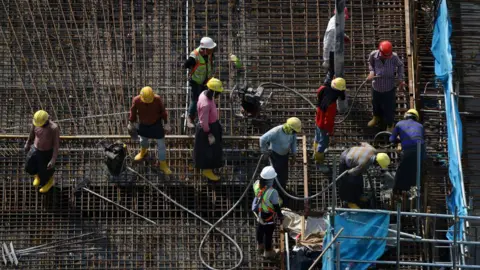BBC News, Singapore
 Pub
PubWhen a 3 meter (10 ft) deep Sinkhol swallowed a black mazda on a busy Singapore road, a group of workers jumped into action at a nearby construction site.
Holding a rope from his work site, he threw it to the female driver in Sinkhol, who got out of the car by this time.
Within five minutes, they managed to pull her for safety.
“I was scared, but every feeling (SIC) was that this woman should be rescued first,” the construction site Foreman Sapiya Pichai Udayapan later told reporters later.
The footage of the incident quickly went viral on social media, including many activists as heroes.
Shri Udayapan is a “migrant worker” – a word used in Singapore to describe 1.17 million laborers who come to the state of rich city from lower income countries such as Bangladesh, India and Myanmar.
A vast majority of them work in low-paying and labor intensive jobs that people of Singapore do zo.
This is not the first time migrant workers have worked as respondents first to save their lives in Singapore. In April, four of them helped to save the children trapped in a shffhouse after the fire.
His recent tasks have revived a debate on the rights of low -paid laborers in Singapore.
Singapore’s fast growing economy is made on the back of these workers who create about three fourths of the country’s foreign workforce. Many of them work in areas such as construction, marine shipyard and manufacturing
While Singapore does not have any minimum wages, according to labor advocacy groups earn less as $ 300 ($ 233; £ 175) in a month, and they live in crowded dormitory which are often located away from residential areas.
Nevertheless they are often subject to abuses by recruitment agencies and their employers, including overwork, unpaid labor and poor conditions. These issues are well documented, but activists say that there has been little change in the last few years.
“Today, you celebrate them. Tomorrow, you will return to normalize them as cheating, false and dirty,” social activist Surer Kumar wrote on Instagram in response to the incident of Sinkhol.
During the Kovid epidemic in 2020, their living conditions were placed bare after the virus emerged as a hotband, with hundreds of workers conducting daily positive tests.
This made a public discussion about their terms – which were warned by the advocates for decades – and the authorities later took action to improve the hostel standards.
Another consistent issue, on which the phenomenon of synchole has again put a spotlight, is the use of flat-bed trucks to give these workers a ferry.
“Something poignantly is poetic about the fact that the migrant laborer, possibly taken to the back of Laurie, went out of his way to save a Singapore in his car,” said Mr. Kumar, who is a member of the activists of the Rights Group.
Singapore laws prevent people from traveling on cargo decks of such trucks – except for medical emergency situations. But it is allowed if they are employed by the owners of trucks.
Sometimes, 12 workers are packed behind a flat-bed truck, with no seatbelt. It is an affordable option for many employers that also use trucks to transport goods.
But this led to many accidents, some deaths.
In April 2021, two foreign workers were killed and more than a dozen injured, as Lauries crashed into a stable flat-bed truck.
In 2024, at least four workers were killed and more than 400 injured in similar accidents.
 BBC/Gavin Butler
BBC/Gavin ButlerThe activists have long advocated to ban this method of transport – the issue has been repeatedly debated in Parliament – but has changed very little.
The Singapore government repeatedly states that while it is encouraging companies to transport workers in buses, lump sum restrictions on such trucks are not possible for small businesses.
“Many of them can be forced to close both of them, both local and foreign jobs,” a senior Minister of State told Parliament in February.
“This will cause delays for important projects such as (public housing), schools, hospitals and (train) lines, and will result in high cost for Singapuri.”
The activists criticized the authorities for reducing the rights of workers for economic views, given that other countries who have very much trusting migrant workers, including the United Arab Emirates and Bahrain, have transported people on trucks.
The levy collected from foreign workers can be used to subsidize businesses and other methods of transport without passing the cost, Mr. Kumar suggested.
The government’s rhetoric “preserves the status quo (and) in the hands of employers, holds uneven power in the hands of migrant workers,” Jaya Anil Kumar, senior researcher of the human organization for migration economics, said, “Another organization that advocates the rights of migrants.”
The ban on lorry ride is only one of the list that is calling for advocates, including a living wage, strong whistleblower security, and subsidized healthcare.
Despite dedicating Singapore to decades of life, these workers have no way to keep the roots down due to the type of work permit, which are different from foreign professionals and officials.
They cannot qualify for a permanent residence, no matter how long they can work in the country. For example, Mr. Udayapan, who directed the previous weekend’s Sinkhole rescue effort, has been working here for 22 years.
Work permit holders also need government approval to marry Singapuri – activists of another issue have been exposed for years.
Ms. Anil Kumar said, “The legislative change has slowed down as there is insufficient political will to implement impressive changes.”
 Getty images
Getty imagesRecognition or tokenism?
At the beginning of this week, the authorities included seven workers involved in Sinkhol rescue with memorial coins, in which a state minister “described his actions” a very good example of how migrants help society in general “.
But many people have criticized the move as tokenism.
Mr. Kumar said, “No amount of ‘thanks’ for his valor should not be made an excuse for the exploitative economic model.
Many people echoed these ideas on social and said that men were entitled to more acknowledgment. Some called him a monetary award and even a permanent residence.
The Ministry of Manpower of Singapore said in a statement to the BBC that “to receive” response to more forms of appreciation for migrant workers “has been encouraged, but did not address specific suggestions raised.
The ministry spokesman said in response to the Quaris, “His everyday acts of care and bravery should be accepted.
Rainkots of the Pravasi Rights Group have raised $ 72,000 ($ 55,840; £ 41,790) from their own funding, which will be equally divided into seven men.
AKM Mohsin, who runs an activity center for Bangladeshi workers in Central Singapore, said, “Many times, we have seen how these migrant workers put their lives at risk to protect many citizens from dangerous conditions.”
“They make news and are held as excellent examples of human functions, but their own humanity and human rights are constantly violated at their workplaces, how they are taken, and how they live,” said Mr. Mohsin.
However, awareness about the issues of migrant workers has increased over the years.
The advocacy groups and the government have organized activities that bring workers and broad community together.
For example, Mr. Mohsin runs a place for migrant workers to write, dance and play music – Singapore has helped translate and publish their works, and often provide an audience for their performance.
But some activists say that most of the migrant workers in the country are seen as a class which is different and inferior from the local community.
Many live and work in industrial areas that are often away from residential areas of the city.
In 2008, some 1,400 residents filed a petition against the construction of a migrant worker hostel near their homes at the Serangoon Gardens in an upper middle class neighborhood.
To calm them down, the authorities reduced the size of the dormitory and constructed a separate road for workers to reach the dormitory.
“We basically see them as a separate class of people. We expect them to serve and believe that they are here,” said Alex Au, vice -president of the advocacy group.
“The servants are about to jump to help their master.”
